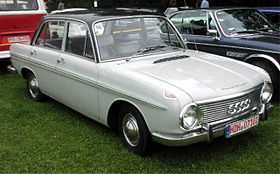DKW F102
| DKW F102 | |
|---|---|
 | |
| Overview | |
| Manufacturer | Auto Union GmbH |
| Production |
1963-1966 53,053 produced[1] |
| Body and chassis | |
| Body style |
2-door saloon 4-door saloon |
| Layout | FF layout |
| Powertrain | |
| Engine |
1175 cc straight-3 two-stroke |
| Transmission |
4-speed manual all-synchromesh [2] |
| Dimensions | |
| Wheelbase | 2,499 mm (98.4 in) |
| Length | 4,280 mm (169 in) |
| Width | 1,618 mm (63.7 in) |
| Height | 1,449 mm (57.0 in) |
| Curb weight |
910 kg (2,010 lb) - 945 kg (2,083 lb) |
| Chronology | |
| Predecessor | Auto Union 1000 |
| Successor | Audi F103 |
The DKW F102 is a car that was produced initially by German manufacturer Auto Union GmbH and later by Volkswagenwerk AG after Volkswagen acquired the Auto Union brands from Daimler-Benz AG in 1964.

The last European built Auto Union 1000 and 1000S models were produced in July 1963 and the DKW F102 was presented as a replacement model in September 1963, although volume production of 2-door F102s began only in March 1964 with four door cars joining them on the production line in January 1965.[3]
It was the last model developed before the Volkswagen take-over. Under Volkswagen control, the F102 provided the basis for the later Audi F103 models (the "Audi" and later "Audi 72", plus 60, 75, 80, and Super 90).
The F102 featured state-of-the-art two-stroke technology for its time and a unibody of modern design. Nevertheless, the market of the 1960s shunned two-stroke engines as old-fashioned. The F102 in consequence sold below the company's expectations and was the source of huge financial losses. Due to this situation Volkswagen was forced to implement a radical change in 1966. The production of two-stroke-engines was ended, with the last F102s produced in March 1966, by when 52,753[3] or 53,053 had been produced.[4] The F102 was redesigned to accommodate a four-cylinder-four-stroke-engine. At this point the name of DKW was abandoned, and the F102 mutated into the Audi F103, the first new Audi model since 1938.